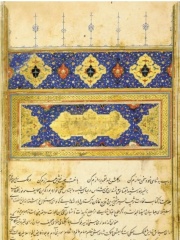



The Most Famous
HISTORIANS from Afghanistan
This page contains a list of the greatest Afghan Historians. The pantheon dataset contains 561 Historians, 4 of which were born in Afghanistan. This makes Afghanistan the birth place of the 24th most number of Historians behind Switzerland, and Romania.
Top 4
The following people are considered by Pantheon to be the most legendary Afghan Historians of all time. This list of famous Afghan Historians is sorted by HPI (Historical Popularity Index), a metric that aggregates information on a biography's online popularity.

1. Minhaj-i-Siraj (1193 - 1260)
With an HPI of 66.00, Minhaj-i-Siraj is the most famous Afghan Historian. His biography has been translated into 23 different languages on wikipedia.
Minhaj-al-Din Abu Amr Othman ibn Siraj-al-Din Muhammad Juzjani (born 1193), simply known as Minhaj al-Siraj Juzjani, was a 13th-century Persian historian born in the region of Ghur. In 1227, Juzjani immigrated to Ucch and, thereafter, to Delhi. The principal historian of the Mamluk Sultanate of Delhi in northern India, Juzjani wrote of the Ghurid dynasty as well. He wrote the Tabaqat-i Nasiri (1260 CE) for Sultan Nasiruddin Mahmud Shah of Delhi. He died after 1266.

2. Abd-al-Razzāq Samarqandī (1413 - 1482)
With an HPI of 64.80, Abd-al-Razzāq Samarqandī is the 2nd most famous Afghan Historian. His biography has been translated into 24 different languages.
Abd-al-Razzāq Samarqandī (Persian: کمالالدین عبدالرزاق بن اسحاق سمرقندی, Kamal-ud-Din Abd-ur-Razzaq ibn Ishaq Samarqandi; 7 November 1413 – August 1482) was a Persian Timurid chronicler and Islamic scholar. He was for a while the ambassador of Shah Rukh, the Timurid dynasty ruler of Persia. In his role as ambassador he visited Kozhikode in south India in the early 1440s. He wrote a narrative of what he saw in Calicut which is valuable as information on Calicut's society and culture. He is also the producer of a lengthy narrative or chronicle of the history of the Timurid dynasty and its predecessors in Central Asia, but this is not so valuable because it is mostly a compilation of material from earlier written sources that are mostly available from elsewhere in the earlier form.

3. Ibn Hibban (883 - 965)
With an HPI of 63.98, Ibn Hibban is the 3rd most famous Afghan Historian. His biography has been translated into 20 different languages.
Muḥammad ibn Hibbān al-Bustī (Arabic: محمد ابن حبان البستی) (c. 270–354/884–965) was a Muslim Arab scholar, polymath and a prominent Shafi'i traditionist, ḥadith critic, evaluator of rijal, compiler and interpreter of hadith. He was a prolific writer and well-versed in numerous Islamic fields such as fiqh (reaching the level of Ijtihad) as well as in the sciences of astronomy, medicine, history and other disciplines.

4. Khvandamir (1475 - 1534)
With an HPI of 60.84, Khvandamir is the 4th most famous Afghan Historian. His biography has been translated into 18 different languages.
Ghiyath al-Din Muhammad, commonly known as Khvandamir (Persian: غیاثالدین خواندمیر, also spelled Khwandamir; 1475/76–1535/36) was a Persian historian who was active in the Timurid, Safavid and Mughal empires. He is principally known for his Persian universal history, the Habib al-siyar (The beloved of careers), which was regarded by both the Safavids and Mughals as their first official court account. Another notable work by Khvandamir is the Qanun-i Humayuni (The regulations of Humayun), a biography of the Mughal emperor Humayun (r. 1530–1540, 1555–1556), which contains important information regarding the early Mughal symbolism of rulership. Khvandamir is buried near the shrine of Nizamuddin Auliya (died 1325) in Delhi, India.
People
Pantheon has 4 people classified as Afghan historians born between 883 and 1475. Of these 4, none of them are still alive today. The most famous deceased Afghan historians include Minhaj-i-Siraj, Abd-al-Razzāq Samarqandī, and Ibn Hibban.
Deceased Afghan Historians
Go to all RankingsMinhaj-i-Siraj
1193 - 1260
HPI: 66.00
Abd-al-Razzāq Samarqandī
1413 - 1482
HPI: 64.80
Ibn Hibban
883 - 965
HPI: 63.98
Khvandamir
1475 - 1534
HPI: 60.84

